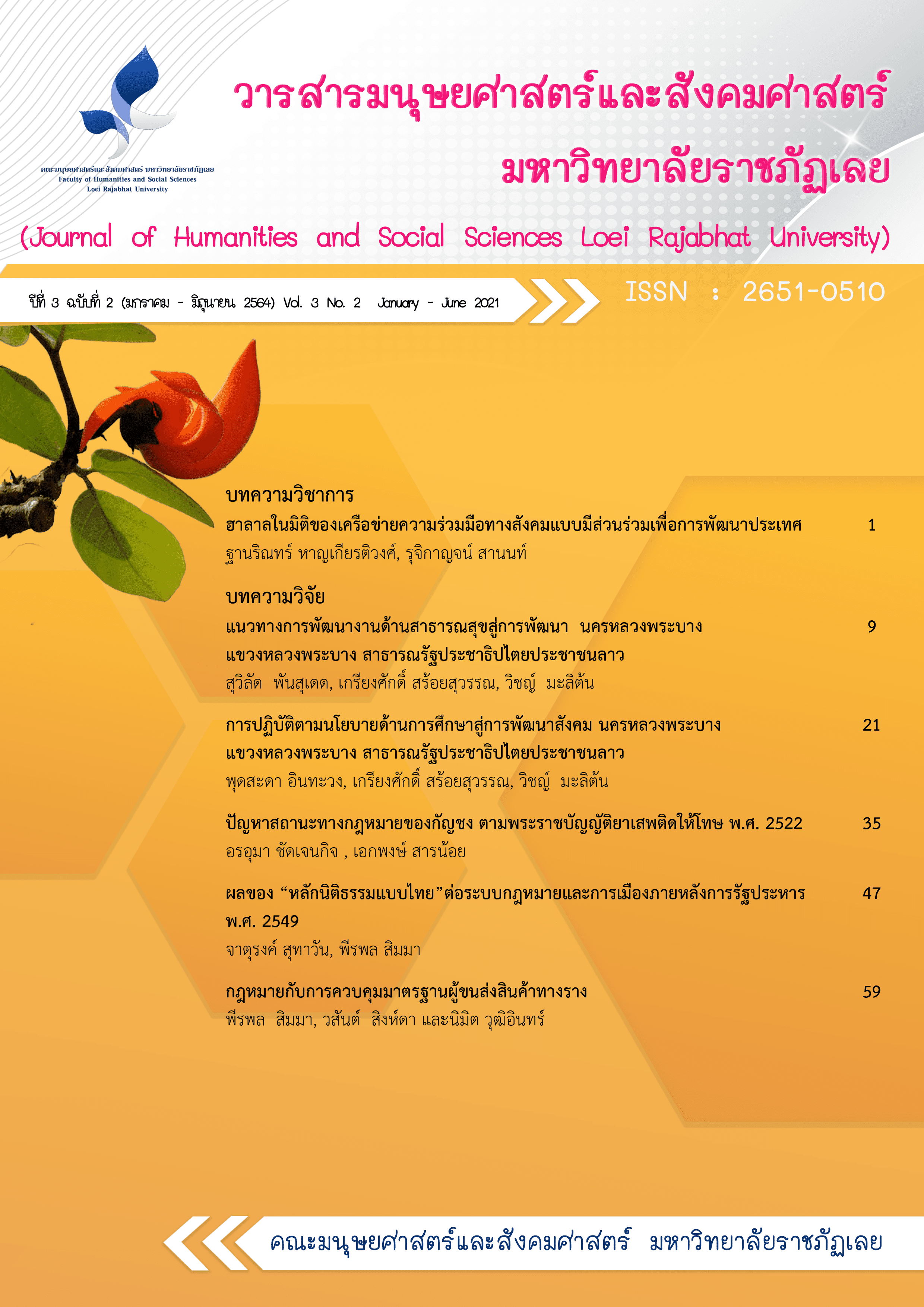ฮาลาลในมิติของเครือข่ายความร่วมมือทางสังคมแบบมีส่วนร่วมเพื่อการพัฒนาประเทศ
คำสำคัญ:
ฮาลาล, เครือข่ายความร่วมมือ, การมีส่วนร่วมทางสังคม, การพัฒนาบทคัดย่อ
บทความวิชาการนี้มีวัตถุประสงค์ เพื่อนำเสนอมุมมองของฮาลาลในมิติของเครือข่ายความร่วมมือทางสังคมแบบมีส่วนร่วมเพื่อการพัฒนาประเทศ ผลการวิเคราะห์ พบว่า รูปแบบฮาลาลในมิติของเครือข่ายความร่วมมือทางสังคมแบบมีส่วนร่วมเพื่อการพัฒนาประเทศใน 8 ด้าน ได้แก่ 1) การพัฒนาระบบสาธารณูปโภค 2) การพัฒนาสังคมจิตวิทยา 3) การพัฒนาเศรษฐกิจ 4) การพัฒนาระบบการศึกษา 5) การพัฒนากระบวนการยุติธรรม 6) การพัฒนาเครือข่ายโทรคมนาคม 7) การพัฒนาการค้าและการลงทุน และ 8) การพัฒนาการเมือง โดยในการพัฒนาแต่ละด้านต้องเกิดขึ้นจากความร่วมมือจากภาครัฐ ภาคเอกชน ภาคประชาชน และภาคประชาสังคมร่วมกัน ตัดสินใจ ร่วมดำเนินงาน ร่วมรับผลประโยชน์ และร่วมประเมินผลการทำงานร่วมกันในรูปแบบของเครือข่ายความร่วมมือแบบมีส่วนร่วมเพื่อการพัฒนาประเทศไทยอย่างยั่งยืน
เอกสารอ้างอิง
กองส่งเสริมและพัฒนาเครือข่าย. (2547). รายงานการวิจัยสถานการณ์เครือข่ายด้านเด็ก เยาวชน ผู้ด้อยโอกาส คนพิการและผู้สูงอายุ. กรุงเทพฯ: สำนักงานส่งเสริมสวัสดิภาพและพิทักษณ์เด็ก เยาวชน กระทรวงการพัฒนาสังคมและความมั่นคงของมนุษย์.
ชัชวาล สิงหาทอง, เปรมจิตต์ ขจรภัย ลาร์เซ่น, ช่อเพชร เป้าเงิน และมารุต พัฒนผล. (2563). การพัฒนารูปแบบการบริหารจัดการเครือข่ายความร่วมมือของสถานศึกษาด้านวิชาการของกลุ่มโรงเรียนเฉลิมพระเกียรติสังกัดสำนักงานคณะกรรมการการศึกษาขั้นพื้นฐาน, Journal of Modern Learning Development, 5(1), 231-245.
นันทรัตน์ นามบุรี, สันติ อารักษ์คุณากร, ไญยิกา ยอดสุดเอียม, อัลอามีน มะแต, อาดัม ไกรสุทรังค์, มนัส สุทธิการ และ ฮาซียะห์ ดอรอแซ. (2561). การพัฒนากลุ่มวิสาหกิจชุมชนผู้ผลิตอาหารฮาลาลในเขตสามจังหวัดชายแดนใต้เพื่อสร้างความสามารถทางการแข่งขันทางการค้าสู่สากล, ได้รับทุนอุดหนุนจากงบประมาณแผ่นดินประจำปี 2561.
ปิ่นมนัส จันทนวงษ์. (2562). การท่องเที่ยวแบบฮาลาลมีอิทธิพลต่อความพึงพอใจในการให้บริการของนักท่องเที่ยวมุสลิมในจังหวัดชลบุรี, หลักสูตรบริหารธุรกิจมหาบัณฑิต สาขาวิชาการจัดการธุรกิจโลก วิทยาลัยพาณิชยศาสตร์ มหาวิทยาลัยบูรพา.
สำนักงานมาตรฐานสินค้าเกษตรและอาหารแห่งชาติ. (2564). มาตรฐานอาหารฮาลาลแห่งชาติ, สืบค้นเมื่อ 25 มีนาคม พ.ศ. 2564, จาก https://www.acfs.go.th/halal/general.php
ศูนย์วิจัยกสิกรไทย. (2561). โอกาส SME ไทย ชิงตลาดฮาลาลโลก, สืบค้นเมื่อ 25 มีนาคม พ.ศ. 2564, จาก https://www.kasikornbank.com/th/business/sme/KSMEKnowledge/article/KSMEAnalysis/Documents/Thai-SME-Opportunity_Halal-Market.pdf
อารยา อายุบเคน และวิโรจน์ เจษฎาลักษณ์. (2558).มาตรฐานการดำเนินงานการผลิตอาหารภายใต้เครื่องหมายฮาลาลของผู้ประกอบการธุรกิจอาหารในจังหวัดนนทบุรี, Veridian E-Journal, Silpakorn University, ฉบับภาษาไทย สาขามนุษยศาสตร์ สังคมศาสตร์ และศิลปะ, 8(2), 1327-1340.
อิสมาแอล เบญอิบรอฮีม และ ธนสฤษฏิ์ สตเวทิต. (2561). วัฒนธรรมแบบมีส่วนร่วมทางการเมืองของประชาชนกับการพัฒนาความมั่นคงในพื้นที่สามจังหวัดชายแดนใต้ของไทย, บัณฑิตวิทยาลัย มหาวิทยาลัยสวนดุสิต. ปีที่ 14 ฉบับที่ 3 ประจำเดือนกันยาน-ธันวาคม 2561, 79-90.
Cohen, J. M., & Uphoff, N. T. (1980). Participation's place in rural development: seeking clarity through specificity. World development, 8(3), 213-235.
Dong, X., Yu, C., & Hwang, Y. S. (2021). The Effects of Reverse Knowledge Spillover on China’s Sustainable Development: Sustainable Development Indicators Based on Institutional Quality. Sustainability, 13(4), 1628.
Fornaroff, A. (1980). Community Involvement in Health System for Primary Health Care. Geneva: World Health Organization.
Gerber, M. L. (2020). Global Health Security and Development Indicators (Doctoral dissertation, Tulane University, Payson Center for International Development).
Kittayarak, K. (2003). The Thai Constitution of 1997 and its implication on criminal justice reform. Resource Material Series of United Nations Asia and Far East Institute For the Prevention of Crime and the Treatment of Offenders, 60, 107-117.
Nilsson, A. E., & Larsen, J. N. (2020). Making regional sense of global sustainable development indicators for the Arctic. Sustainability, 12(3), 1027.
Oliveira, G. M., Vidal, D. G., Viterbo, L. M. F., & Maia, R. L. (2020). Measuring the implementation of Sustainable Development Goals at a local level: The WeGIx index. In Universities and Sustainable Communities: Meeting the Goals of the Agenda 2030 (pp. 215-245). Springer, Cham.
Vasylieva, T. A., Bilan, S., Bahmet, K. V., & Seliga, R. (2020). Institutional development gap in the social sector: Cross-country analysis.
Wasserman, S., Faust, K., & Faust, K. (1994). Social Network Analysis. Structural Analysis in the Social Sciences.
Worldpopulationreview.com. (2020). Muslim Population By Country 2020, Retrieved date: 25 March, 2021, https://worldpopulationreview.com/country-rankings/muslim-population-by-country
ดาวน์โหลด
เผยแพร่แล้ว
เวอร์ชัน
- 2023-02-27 (2)
- 2021-06-30 (1)










